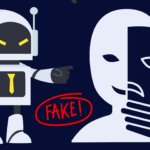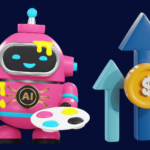🤯 Imagine witnessing a video of your beloved celeb dropping bombshells, pulling off unexpected stunts, or unleashing a political speech that flips the election script! 🎥 This is the mighty, yet potentially perilous, realm of deepfakes.
🚀 Deepfakes aren’t just sci-fi dreams; they’re real in our digital age, shaking up our lives. 🌐 This tech wizardry has big impacts, both good and bad. 🤖 To get it, let’s dive into the techy details and check out how they can be awesome or, well, not so great. 🤔✨
Table of Contents
ToggleA Digital Puppet Show Driven by AI:
Imagine a highly skilled puppeteer controlling the movements and expressions of their puppets with incredible precision. This analogy perfectly captures the essence of deepfakes. Instead of physical puppets, the puppeteer is a complex AI algorithm, and its canvas is digital media.
This AI, trained on massive datasets of images, videos, and audio recordings, becomes an expert in recognizing patterns and characteristics. It meticulously analyzes the target person’s facial features, voice nuances, and body language, effectively learning their “digital signature.”
Once this knowledge is acquired, the magic happens. The AI can manipulate any existing video or audio recording, seamlessly superimposing the target person’s face, voice, and movements onto another individual. This creates the illusion of the target person saying or doing things they never actually did, blurring the lines between reality and fabricated content.
Deep Learning: The Engine Behind the Illusion:
The inner workings of deepfakes involve a sophisticated technology called “deep learning.” This is essentially a type of artificial intelligence that mimics the way the human brain learns.
Just like a child learns to distinguish cats from dogs by observing countless pictures, the deepfake algorithm learns the target person’s unique features by analyzing massive amounts of data. It identifies patterns in facial expressions, voice intonations, and body movements, building a comprehensive model that allows it to manipulate existing media.
Think of it as a master artist meticulously studying a subject’s features and mannerisms before creating a lifelike portrait. The deepfake algorithm uses a similar process, but instead of paints and brushes, it utilizes advanced software and powerful computing resources to achieve its digital artistry.
The Two Sides of the Deepfake Coin:
While deepfakes might seem like a tool solely for mischievous intentions, their potential extends far beyond the realm of manipulation. They have the ability to positively impact various aspects of our lives:
- Entertainment: Deepfakes have opened doors for creative expression, allowing us to see historical figures come to life, relive iconic movie scenes with different actors, and even enjoy humorous parodies of celebrities.
- Education: Deepfakes can be used to create interactive learning experiences, personalize educational content, and bring historical events to life in a more engaging way.
- Social Commentary: Artists and activists can leverage deepfakes to raise awareness about important issues, spark social conversations, and challenge societal norms.
However, the potential for misuse cannot be ignored. Just as a powerful tool can be used for good, it can also be employed for malicious purposes:
Chilling Examples of Deepfake Misuse:
Spreading Misinformation:
- Political Warfare: A deepfake could depict a leader declaring war, causing international panic and market instability. Imagine the chaos if a fake video of President Biden announcing an attack on China went viral.
- Discrediting Individuals: A deepfake could show a scientist making a false claim, damaging their credibility and hindering important research. Imagine if a deepfake video of Dr. Fauci encouraging risky behavior during the pandemic eroded public trust in health experts.
- Eroding Trust in Media: Deepfakes could undermine trust in legitimate news sources by making it difficult to distinguish real news from fabricated content. Imagine a deepfake video showing a news anchor reporting a devastating natural disaster, causing panic and unnecessary fear.
Blackmail and Extortion:
- Corporate Espionage: A deepfake could show a CEO making damaging remarks about a competitor, causing their stock price to plummet. Imagine a deepfake video of Elon Musk criticizing Tesla’s safety record, leading to a major financial crisis.
- Personal Attacks: A deepfake could be used to create a revenge porn video, inflicting unimaginable pain and humiliation on the victim. Imagine a deepfake video of an athlete engaging in sexually inappropriate behavior, effectively destroying their career.
- Cyberbullying: Deepfakes could be used to bully and harass individuals, leading to emotional distress and even suicide. Imagine a deepfake video circulating online showing a student making hateful remarks, ostracizing them from their peers.
Financial Fraud:
- Identity Theft: Deepfakes could be used to impersonate individuals in order to access bank accounts, credit cards, and other sensitive information. Imagine a deepfake of a celebrity being used to steal millions of dollars from their fans.
- Fraudulent Transactions: Deepfakes could be used to trick automated systems such as facial recognition software, allowing criminals to gain access to restricted areas or commit financial crimes. Imagine a deepfake used to bypass facial recognition security at a secure facility and steal valuable assets.
- Market Manipulation: Deepfakes could be used to create fake videos of financial experts making false recommendations, leading investors to make unwise decisions. Imagine a deepfake video of Warren Buffett predicting a market crash, causing widespread panic and selling.
Case Study: Rashmika Mandanna:
- The deepfake video of Rashmika Mandanna highlights the potential for deepfakes to cause emotional distress and damage reputations. Imagine the impact if this video had been used to extort money from her or sabotage her career.
- This case serves as a warning that anyone can be a victim of deepfakes, regardless of their status or profession. It underscores the need for individuals to be vigilant about the information they consume online and to take steps to protect their privacy.
Beyond These Examples:
- Deepfakes can be used to manipulate elections, incite violence, and erode trust in institutions. They pose a significant threat to democracy, social stability, and individual well-being.
- As deepfake technology continues to evolve, the potential for misuse will only grow. It is crucial to develop effective detection methods, legal frameworks, and ethical guidelines to mitigate the risks associated with this technology.
This is just a glimpse into the potential dangers of deepfakes. As this technology continues to evolve, it is essential to be aware of its malicious uses and to take steps to protect ourselves.
The Legal Landscape of Deepfakes: A Global Perspective
The legality of deepfakes currently varies widely across different jurisdictions. Some countries have implemented specific laws addressing deepfakes, while others rely on existing legal frameworks to address related issues like defamation, privacy invasion, and intellectual property infringement.
Here’s a brief overview of the legal landscape for deepfakes in some key regions:
United States:
- California Consumer Privacy Act (CCPA): Requires companies to obtain consent before collecting and using personal data, including biometric data like facial images. This could be interpreted to restrict the use of deepfakes without consent.
- State laws: Several states have passed laws prohibiting the creation or distribution of deepfakes without consent, particularly for malicious purposes like revenge porn.
United Kingdom:
- Digital Economy Act 2017: Includes provisions against online harms, potentially encompassing the creation or distribution of harmful deepfakes.
- Defamation laws: Existing laws could apply to deepfakes that cause damage to someone’s reputation.
European Union:
- General Data Protection Regulation (GDPR): Provides individuals with robust control over their personal data, which could limit the use of deepfakes without consent.
- E-commerce Directive: Prohibits unfair commercial practices, which could apply to the use of deepfakes in misleading advertising.
China:
- No specific laws: Current laws address broader issues like defamation and online harms, but may not be explicitly tailored to deepfakes.
- Regulation of internet platforms: The government heavily regulates internet platforms, which could be used to restrict the spread of harmful deepfakes.
Global Efforts:
- Council of Europe: Working on a Recommendation on Artificial Intelligence, including provisions on deepfakes.
- Organization for Economic Co-operation and Development (OECD): Developing AI Principles that address ethical considerations related to deepfakes.
Challenges and Considerations:
- Balancing freedom of expression with the need to protect individuals and society from harm.
- Defining clear legal boundaries for acceptable and unacceptable uses of deepfakes.
- Developing effective detection and enforcement mechanisms to combat illegal deepfakes.
- Adapting existing legal frameworks to address the evolving nature of deepfake technology.
The legal landscape surrounding deepfakes is constantly evolving. As the technology continues to develop, it’s crucial for policymakers, legal experts, and technology developers to work together to ensure that deepfakes are used responsibly and ethically.
Here are some additional points to consider:
- The severity of legal penalties for deepfake offenses varies depending on the jurisdiction.
- The burden of proof lies with the person claiming harm from a deepfake.
- Technology companies have a significant role to play in combating the spread of harmful deepfakes.
- Individuals can take steps to protect themselves from deepfakes, such as being cautious about the information they share online and using privacy-enhancing technologies.
So, what can we do to protect ourselves from falling victim to these digital tricksters?
Here are some essential steps:
- Be critical: Don’t blindly believe everything you see online. Question the source of the information, scrutinize the video for inconsistencies, and fact-check the content before sharing it.
- Look for the telltale signs: Deepfakes can often reveal themselves through subtle inconsistencies in lip movements, eye blinking, and skin texture. Train your eye to spot these subtle clues that might hint at digital manipulation.
- Embrace fact-checking tools: As technology advances, so too do tools designed to detect deepfakes. Utilize these resources to verify the authenticity of videos before accepting them as truth.
- Demand legal accountability: We must urge policymakers to create and enforce robust laws that hold individuals and corporations accountable for the misuse of deepfakes.
The future of deepfakes remains uncertain. While the potential for harm is undeniable, so too is the potential for creative expression and positive social impact. By approaching this technology with a healthy dose of skepticism, critical thinking, and a demand for ethical use, we can navigate the complex world of deepfakes and ensure that they are used for good, not harm.
Be careful online. Not everything you see or hear is true. Ask questions and think carefully before believing things. If we all do this, we can make sure bad stuff doesn’t spread. Let’s use the internet for good things, like being creative and helpful.















